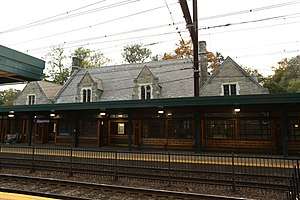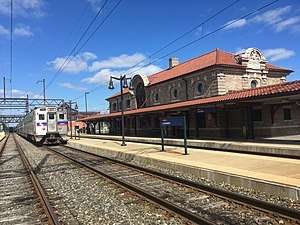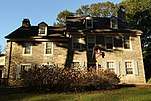Lansdale/Doylestown Line
The Lansdale/Doylestown Line is a SEPTA Regional Rail line connecting Center City Philadelphia to Doylestown in Bucks County, Pennsylvania. Until 1981, diesel-powered trains continued on the Bethlehem Branch from Lansdale to Quakertown, Bethlehem, and Allentown. Restored service has been proposed, but is not planned by SEPTA. The line is currently used by the East Penn Railroad, serving Quakertown's industrial complexes and distribution centers.
| Lansdale/Doylestown Line | |||||||||||||||||||||||||||||||||||||||||||||||||||||||||||||||||||||||||||||||||||||||||||||||||||||||||||||||||||||||||||||||||||||||||||||||||||||||||||||||||||||||||||||||||||||||||||||||||||||||||||||||||||||||||||||||||||||||||||||||||||||||||||||||||||||||||||||||||||||||||||||||||||||||||||||||||||||||||||||||||||||||||||||||||||||||||||||||||||||||||||||||||||||||||||||||||||||||||||||||||||||||||||||||||||||||||||
|---|---|---|---|---|---|---|---|---|---|---|---|---|---|---|---|---|---|---|---|---|---|---|---|---|---|---|---|---|---|---|---|---|---|---|---|---|---|---|---|---|---|---|---|---|---|---|---|---|---|---|---|---|---|---|---|---|---|---|---|---|---|---|---|---|---|---|---|---|---|---|---|---|---|---|---|---|---|---|---|---|---|---|---|---|---|---|---|---|---|---|---|---|---|---|---|---|---|---|---|---|---|---|---|---|---|---|---|---|---|---|---|---|---|---|---|---|---|---|---|---|---|---|---|---|---|---|---|---|---|---|---|---|---|---|---|---|---|---|---|---|---|---|---|---|---|---|---|---|---|---|---|---|---|---|---|---|---|---|---|---|---|---|---|---|---|---|---|---|---|---|---|---|---|---|---|---|---|---|---|---|---|---|---|---|---|---|---|---|---|---|---|---|---|---|---|---|---|---|---|---|---|---|---|---|---|---|---|---|---|---|---|---|---|---|---|---|---|---|---|---|---|---|---|---|---|---|---|---|---|---|---|---|---|---|---|---|---|---|---|---|---|---|---|---|---|---|---|---|---|---|---|---|---|---|---|---|---|---|---|---|---|---|---|---|---|---|---|---|---|---|---|---|---|---|---|---|---|---|---|---|---|---|---|---|---|---|---|---|---|---|---|---|---|---|---|---|---|---|---|---|---|---|---|---|---|---|---|---|---|---|---|---|---|---|---|---|---|---|---|---|---|---|---|---|---|---|---|---|---|---|---|---|---|---|---|---|---|---|---|---|---|---|---|---|---|---|---|---|---|---|---|---|---|---|---|---|---|---|---|---|---|---|---|---|---|---|---|---|---|---|---|---|---|---|---|---|---|---|---|---|---|---|---|---|---|---|---|---|---|---|---|---|---|---|---|---|---|---|---|---|---|---|---|---|---|---|---|---|---|---|---|---|---|---|---|---|---|---|---|---|---|---|---|---|---|---|---|
 Jenkintown-Wyncote station, a major stop on the Lansdale/Doylestown line | |||||||||||||||||||||||||||||||||||||||||||||||||||||||||||||||||||||||||||||||||||||||||||||||||||||||||||||||||||||||||||||||||||||||||||||||||||||||||||||||||||||||||||||||||||||||||||||||||||||||||||||||||||||||||||||||||||||||||||||||||||||||||||||||||||||||||||||||||||||||||||||||||||||||||||||||||||||||||||||||||||||||||||||||||||||||||||||||||||||||||||||||||||||||||||||||||||||||||||||||||||||||||||||||||||||||||||
| Overview | |||||||||||||||||||||||||||||||||||||||||||||||||||||||||||||||||||||||||||||||||||||||||||||||||||||||||||||||||||||||||||||||||||||||||||||||||||||||||||||||||||||||||||||||||||||||||||||||||||||||||||||||||||||||||||||||||||||||||||||||||||||||||||||||||||||||||||||||||||||||||||||||||||||||||||||||||||||||||||||||||||||||||||||||||||||||||||||||||||||||||||||||||||||||||||||||||||||||||||||||||||||||||||||||||||||||||||
| Type | Commuter rail | ||||||||||||||||||||||||||||||||||||||||||||||||||||||||||||||||||||||||||||||||||||||||||||||||||||||||||||||||||||||||||||||||||||||||||||||||||||||||||||||||||||||||||||||||||||||||||||||||||||||||||||||||||||||||||||||||||||||||||||||||||||||||||||||||||||||||||||||||||||||||||||||||||||||||||||||||||||||||||||||||||||||||||||||||||||||||||||||||||||||||||||||||||||||||||||||||||||||||||||||||||||||||||||||||||||||||||
| System | SEPTA Regional Rail | ||||||||||||||||||||||||||||||||||||||||||||||||||||||||||||||||||||||||||||||||||||||||||||||||||||||||||||||||||||||||||||||||||||||||||||||||||||||||||||||||||||||||||||||||||||||||||||||||||||||||||||||||||||||||||||||||||||||||||||||||||||||||||||||||||||||||||||||||||||||||||||||||||||||||||||||||||||||||||||||||||||||||||||||||||||||||||||||||||||||||||||||||||||||||||||||||||||||||||||||||||||||||||||||||||||||||||
| Status | Operating | ||||||||||||||||||||||||||||||||||||||||||||||||||||||||||||||||||||||||||||||||||||||||||||||||||||||||||||||||||||||||||||||||||||||||||||||||||||||||||||||||||||||||||||||||||||||||||||||||||||||||||||||||||||||||||||||||||||||||||||||||||||||||||||||||||||||||||||||||||||||||||||||||||||||||||||||||||||||||||||||||||||||||||||||||||||||||||||||||||||||||||||||||||||||||||||||||||||||||||||||||||||||||||||||||||||||||||
| Locale | Philadelphia Montgomery County Bucks County | ||||||||||||||||||||||||||||||||||||||||||||||||||||||||||||||||||||||||||||||||||||||||||||||||||||||||||||||||||||||||||||||||||||||||||||||||||||||||||||||||||||||||||||||||||||||||||||||||||||||||||||||||||||||||||||||||||||||||||||||||||||||||||||||||||||||||||||||||||||||||||||||||||||||||||||||||||||||||||||||||||||||||||||||||||||||||||||||||||||||||||||||||||||||||||||||||||||||||||||||||||||||||||||||||||||||||||
| Termini | 30th Street Station Doylestown | ||||||||||||||||||||||||||||||||||||||||||||||||||||||||||||||||||||||||||||||||||||||||||||||||||||||||||||||||||||||||||||||||||||||||||||||||||||||||||||||||||||||||||||||||||||||||||||||||||||||||||||||||||||||||||||||||||||||||||||||||||||||||||||||||||||||||||||||||||||||||||||||||||||||||||||||||||||||||||||||||||||||||||||||||||||||||||||||||||||||||||||||||||||||||||||||||||||||||||||||||||||||||||||||||||||||||||
| Stations | 28 | ||||||||||||||||||||||||||||||||||||||||||||||||||||||||||||||||||||||||||||||||||||||||||||||||||||||||||||||||||||||||||||||||||||||||||||||||||||||||||||||||||||||||||||||||||||||||||||||||||||||||||||||||||||||||||||||||||||||||||||||||||||||||||||||||||||||||||||||||||||||||||||||||||||||||||||||||||||||||||||||||||||||||||||||||||||||||||||||||||||||||||||||||||||||||||||||||||||||||||||||||||||||||||||||||||||||||||
| Daily ridership | 16,016[1] | ||||||||||||||||||||||||||||||||||||||||||||||||||||||||||||||||||||||||||||||||||||||||||||||||||||||||||||||||||||||||||||||||||||||||||||||||||||||||||||||||||||||||||||||||||||||||||||||||||||||||||||||||||||||||||||||||||||||||||||||||||||||||||||||||||||||||||||||||||||||||||||||||||||||||||||||||||||||||||||||||||||||||||||||||||||||||||||||||||||||||||||||||||||||||||||||||||||||||||||||||||||||||||||||||||||||||||
| Website | septa.org | ||||||||||||||||||||||||||||||||||||||||||||||||||||||||||||||||||||||||||||||||||||||||||||||||||||||||||||||||||||||||||||||||||||||||||||||||||||||||||||||||||||||||||||||||||||||||||||||||||||||||||||||||||||||||||||||||||||||||||||||||||||||||||||||||||||||||||||||||||||||||||||||||||||||||||||||||||||||||||||||||||||||||||||||||||||||||||||||||||||||||||||||||||||||||||||||||||||||||||||||||||||||||||||||||||||||||||
| Operation | |||||||||||||||||||||||||||||||||||||||||||||||||||||||||||||||||||||||||||||||||||||||||||||||||||||||||||||||||||||||||||||||||||||||||||||||||||||||||||||||||||||||||||||||||||||||||||||||||||||||||||||||||||||||||||||||||||||||||||||||||||||||||||||||||||||||||||||||||||||||||||||||||||||||||||||||||||||||||||||||||||||||||||||||||||||||||||||||||||||||||||||||||||||||||||||||||||||||||||||||||||||||||||||||||||||||||||
| Operator(s) | SEPTA | ||||||||||||||||||||||||||||||||||||||||||||||||||||||||||||||||||||||||||||||||||||||||||||||||||||||||||||||||||||||||||||||||||||||||||||||||||||||||||||||||||||||||||||||||||||||||||||||||||||||||||||||||||||||||||||||||||||||||||||||||||||||||||||||||||||||||||||||||||||||||||||||||||||||||||||||||||||||||||||||||||||||||||||||||||||||||||||||||||||||||||||||||||||||||||||||||||||||||||||||||||||||||||||||||||||||||||
| Character | Grade-separated and At-grade street running | ||||||||||||||||||||||||||||||||||||||||||||||||||||||||||||||||||||||||||||||||||||||||||||||||||||||||||||||||||||||||||||||||||||||||||||||||||||||||||||||||||||||||||||||||||||||||||||||||||||||||||||||||||||||||||||||||||||||||||||||||||||||||||||||||||||||||||||||||||||||||||||||||||||||||||||||||||||||||||||||||||||||||||||||||||||||||||||||||||||||||||||||||||||||||||||||||||||||||||||||||||||||||||||||||||||||||||
| Depot(s) | SEPTA Yards and maintenance facilities | ||||||||||||||||||||||||||||||||||||||||||||||||||||||||||||||||||||||||||||||||||||||||||||||||||||||||||||||||||||||||||||||||||||||||||||||||||||||||||||||||||||||||||||||||||||||||||||||||||||||||||||||||||||||||||||||||||||||||||||||||||||||||||||||||||||||||||||||||||||||||||||||||||||||||||||||||||||||||||||||||||||||||||||||||||||||||||||||||||||||||||||||||||||||||||||||||||||||||||||||||||||||||||||||||||||||||||
| Rolling stock | Electric multiple units | ||||||||||||||||||||||||||||||||||||||||||||||||||||||||||||||||||||||||||||||||||||||||||||||||||||||||||||||||||||||||||||||||||||||||||||||||||||||||||||||||||||||||||||||||||||||||||||||||||||||||||||||||||||||||||||||||||||||||||||||||||||||||||||||||||||||||||||||||||||||||||||||||||||||||||||||||||||||||||||||||||||||||||||||||||||||||||||||||||||||||||||||||||||||||||||||||||||||||||||||||||||||||||||||||||||||||||
| Events | |||||||||||||||||||||||||||||||||||||||||||||||||||||||||||||||||||||||||||||||||||||||||||||||||||||||||||||||||||||||||||||||||||||||||||||||||||||||||||||||||||||||||||||||||||||||||||||||||||||||||||||||||||||||||||||||||||||||||||||||||||||||||||||||||||||||||||||||||||||||||||||||||||||||||||||||||||||||||||||||||||||||||||||||||||||||||||||||||||||||||||||||||||||||||||||||||||||||||||||||||||||||||||||||||||||||||||
| Electrification | July 26, 1931 | ||||||||||||||||||||||||||||||||||||||||||||||||||||||||||||||||||||||||||||||||||||||||||||||||||||||||||||||||||||||||||||||||||||||||||||||||||||||||||||||||||||||||||||||||||||||||||||||||||||||||||||||||||||||||||||||||||||||||||||||||||||||||||||||||||||||||||||||||||||||||||||||||||||||||||||||||||||||||||||||||||||||||||||||||||||||||||||||||||||||||||||||||||||||||||||||||||||||||||||||||||||||||||||||||||||||||||
| Technical | |||||||||||||||||||||||||||||||||||||||||||||||||||||||||||||||||||||||||||||||||||||||||||||||||||||||||||||||||||||||||||||||||||||||||||||||||||||||||||||||||||||||||||||||||||||||||||||||||||||||||||||||||||||||||||||||||||||||||||||||||||||||||||||||||||||||||||||||||||||||||||||||||||||||||||||||||||||||||||||||||||||||||||||||||||||||||||||||||||||||||||||||||||||||||||||||||||||||||||||||||||||||||||||||||||||||||||
| Track gauge | 4 ft 8 1⁄2 in (1,435 mm) standard gauge | ||||||||||||||||||||||||||||||||||||||||||||||||||||||||||||||||||||||||||||||||||||||||||||||||||||||||||||||||||||||||||||||||||||||||||||||||||||||||||||||||||||||||||||||||||||||||||||||||||||||||||||||||||||||||||||||||||||||||||||||||||||||||||||||||||||||||||||||||||||||||||||||||||||||||||||||||||||||||||||||||||||||||||||||||||||||||||||||||||||||||||||||||||||||||||||||||||||||||||||||||||||||||||||||||||||||||||
| Electrification | SEPTA's 25 Hz traction power system Amtrak's 25 Hz traction power system | ||||||||||||||||||||||||||||||||||||||||||||||||||||||||||||||||||||||||||||||||||||||||||||||||||||||||||||||||||||||||||||||||||||||||||||||||||||||||||||||||||||||||||||||||||||||||||||||||||||||||||||||||||||||||||||||||||||||||||||||||||||||||||||||||||||||||||||||||||||||||||||||||||||||||||||||||||||||||||||||||||||||||||||||||||||||||||||||||||||||||||||||||||||||||||||||||||||||||||||||||||||||||||||||||||||||||||
| Route number | R5 Doylestown and R5 Lansdale (1984-2010) | ||||||||||||||||||||||||||||||||||||||||||||||||||||||||||||||||||||||||||||||||||||||||||||||||||||||||||||||||||||||||||||||||||||||||||||||||||||||||||||||||||||||||||||||||||||||||||||||||||||||||||||||||||||||||||||||||||||||||||||||||||||||||||||||||||||||||||||||||||||||||||||||||||||||||||||||||||||||||||||||||||||||||||||||||||||||||||||||||||||||||||||||||||||||||||||||||||||||||||||||||||||||||||||||||||||||||||
| |||||||||||||||||||||||||||||||||||||||||||||||||||||||||||||||||||||||||||||||||||||||||||||||||||||||||||||||||||||||||||||||||||||||||||||||||||||||||||||||||||||||||||||||||||||||||||||||||||||||||||||||||||||||||||||||||||||||||||||||||||||||||||||||||||||||||||||||||||||||||||||||||||||||||||||||||||||||||||||||||||||||||||||||||||||||||||||||||||||||||||||||||||||||||||||||||||||||||||||||||||||||||||||||||||||||||||
History
The Lansdale/Doylestown Line utilizes what is known as the SEPTA Main Line, a four-track line that has been owned by SEPTA since 1983 (prior to that, by Conrail between 1976 and 1983 and by the Reading Railroad before 1976), and the former Reading Railroad (RDG) Doylestown Branch. Historically, the main part of the line, from Philadelphia north to Lansdale, was part of the Reading Railroad's route from Philadelphia to Bethlehem, and then to Wilkes-Barre and Scranton.
.jpg)
Originally arriving and departing at the former Reading Terminal, now part of the Pennsylvania Convention Center, the line has, since 1985, been directly connected to the ex-PRR/Penn Central side by the Center City Commuter Rail Tunnel. Unlike the ex-PRR/Penn Central Paoli/Thorndale Line it is often paired with for through-service, the ex-RDG line was not as heavily built, as the RDG segregated its through-freight and passenger movements. While the four-track section between the tunnel and Wayne Junction and the two-track section from Wayne Junction to Jenkintown are grade-separated, the two-track section from Jenkintown to Lansdale and the single track from Lansdale to Doylestown has both at-grade railroad crossings and over- and underpasses.[2]
Electrified service between Philadelphia and Hatboro, Lansdale, Doylestown and West Trenton was opened on July 26, 1931. Equipment consisted of dark green painted electric multiple unit cars built at the Reading's own shops. Some of the cars were rebuilt during the 1960s receiving air conditioning, refreshed interior and a new blue paint scheme resulting in their being referred to as "Blueliners". Today, the line uses the Silverliner family of EMU cars which operate throughout SEPTA's Regional Rail system.[2]
Service to Bethlehem and the Lehigh Valley languished due to the post-World War II surge of the automobile as well as the opening of the Pennsylvania Turnpike Northeast Extension in 1957. Service north of Lansdale in the non-electrified territory was terminated by SEPTA on July 29, 1981.[2] Trackage north of Quakertown was dismantled after the railbed was leased for use as the interim Saucon Rail Trail.
Between 1984–2010 the route was designated R5 Doylestown and R5 Lansdale as part of SEPTA's diametrical reorganization of its lines. Lansdale and Doylestown trains operated through the city center to the Paoli Line on the ex-Pennsylvania side of the system.[3] The R-number naming system was dropped on July 25, 2010.[4] As of 2019, most Lansdale/Doylestown Line trains continue through Center City to Malvern or Thorndale on the Paoli/Thorndale Line on weekdays and to Marcus Hook or Wilmington on the Wilmington/Newark Line on weekends.[5]
On August 29, 2011, SEPTA adjusted the midday service pattern to encourage ridership at Colmar station, which had available parking capacity immediately adjacent to Pennsylvania Route 309. Previously, every other train turned back at Lansdale; those trains now call at Colmar before terminating at Link Belt, providing half-hourly service at Colmar between the morning and afternoon rush hours.[6]
On December 18, 2011, SEPTA eliminated weekend service at Link Belt and New Britain due to low ridership. In the fall of 2012, New Britain was added back to the weekend schedule as a flag stop.
A large parking garage is to be built at Lansdale station. 9th Street station opened nearby on November 15, 2015 as an alternate parking location during construction; it will remain open afterwards to as part of planned transit-oriented development.[7]
SEPTA activated positive train control on the Lansdale/Doylestown Line from Doylestown to Glenside on June 13, 2016. Positive train control was activated from Glenside to Fern Rock on December 12, 2016 and from Fern Rock to 30th Street on January 9, 2017.[8]
On April 9, 2020, service on the line was truncated to Lansdale due to the COVID-19 pandemic. Service to Doylestown resumed on June 22, 2020.[9][10]
Stations
The Lansdale/Doylestown Line makes the following station stops after leaving the Center City Commuter Connection; stations indicated with a gray background are closed.
| Zone [11] |
Station | Miles (km) from Center City |
Date opened |
Connections / notes | |
|---|---|---|---|---|---|
| C | Temple University |
2.1 miles (3.4 km) | |||
| 1 | North Broad |
2.9 miles (4.7 km) | |||
| Wayne Junction |
5.1 miles (8.2 km) | ||||
| Logan | One of four stations discontinued by SEPTA on October 4, 1992.[12] | ||||
| Tabor | |||||
| Fern Rock Transportation Center |
7.3 miles (11.7 km) | 1956 | |||
| Philadelphia city line | |||||
| 2 | Melrose Park |
8.4 miles (13.5 km) | |||
| Elkins Park | 9.2 miles (14.8 km) | May 14, 1899[13] | |||
| 3 | Jenkintown–Wyncote | 10.8 miles (17.4 km) | |||
| Glenside | 11.9 miles (19.2 km) | ||||
| North Hills | 13.0 miles (20.9 km) | ||||
| Oreland | 13.9 miles (22.4 km) | ||||
| Fellwick | 14.8 miles (23.8 km) | 1855[14] | Known as Sandy Run from 1855–March 1884,[15] Camp Hill from March 1884–February 16, 1931,[16] and Sellwick.[16] Closed on November 10, 1996 due to low ridership.[17] | ||
| Fort Washington |
15.9 miles (25.6 km) | ||||
| Ambler |
17.3 miles (27.8 km) | 1855[14] | The station was known as Wissahickon until 1869, when it was renamed after Mary Johnson Ambler, a local hero in the Great Train Wreck of 1856.[14] | ||
| Penllyn | 18.8 miles (30.3 km) | ||||
| Gwynedd Valley | 20.0 miles (32.2 km) | ||||
| 4 | North Wales |
22.4 miles (36.0 km) | 1873[18] | ||
| Pennbrook |
23.5 miles (37.8 km) | ||||
| Lansdale |
24.4 miles (39.3 km) | February 7, 1903[19] | |||
| 9th Street |
25.0 miles (40.2 km) | November 15, 2015[20][21] | |||
| Fortuna |
25.9 miles (41.7 km) | ||||
| Colmar |
26.8 miles (43.1 km) | ||||
| Link Belt |
27.5 miles (44.3 km) | December 2, 1952[22] | |||
| Chalfont |
29.7 miles (47.8 km) | BCT: | |||
| New Britain |
31.5 miles (50.7 km) | BCT: | |||
| Delaware Valley University |
32.8 miles (52.8 km) | BCT: | |||
| Doylestown |
34.4 miles (55.4 km) | BCT: | |||
Ridership
Between FY 2008–FY 2018 yearly ridership on the Lansdale/Doylestown Line has held steady at 4.6 million, save for dips to 4.3 million in FY 2010–2011 and FY 2017 and a spike to 5 million in FY 2016.[note 1]
Notes
References
- "Fiscal Year 2020 Annual Service Plan" (PDF). SEPTA. June 2019. p. 42. Retrieved December 14, 2019.
- Williams, Gerry (1998). Trains, Trolleys & Transit: A Guide to Philadelphia Area Rail Transit. Piscataway, New Jersey: Railpace Company. pp. 80–83. ISBN 978-0-9621541-7-1.
- Vuchic, Vukan; Kikuchi, Shinya (1984). General Operations Plan for the SEPTA Regional High Speed System. Philadelphia: SEPTA. pp. 2–8.
- Lustig, David (November 2010). "SEPTA makeover". Trains Magazine. Kalmbach Publishing: 26.
- "Lansdale/Doylestown Line schedule" (PDF). SEPTA. December 16, 2018. Retrieved December 24, 2018.
- "SEPTA adds more Colmar stops". September 1, 2011. Archived from the original on September 7, 2012. Retrieved December 11, 2011.
- "9th Street Station". Southeastern Pennsylvania Transportation Authority. Retrieved 1 November 2015.
- "Positive Train Control Update". SEPTA. May 1, 2017. Retrieved May 17, 2017.
- "Service Information". SEPTA. Retrieved April 14, 2020.
- "SEPTA Regional Rail & Rail Transit Lifeline Service" (PDF). SEPTA. 2020. Retrieved April 14, 2020.
- "Lansdale/Doylestown Line Timetable" (PDF). Philadelphia, Pennsylvania: Southeastern Pennsylvania Transportation Authority. September 10, 2017. Retrieved October 19, 2017.
- "New Rail Schedules Set". The Philadelphia Inquirer. Philadelphia, Pennsylvania. October 2, 1992. p. 36. Retrieved October 19, 2017 – via Newspapers.com.

- "Elkins Station Opened at Ogontz Park". The Philadelphia Times. May 15, 1899. p. 3. Retrieved July 3, 2019 – via Newspapers.com.

- Ambler Borough Open Space Plan. Montgomery County Planning Commission (Report). 2006. p. 2. Retrieved April 17, 2018.
- "Railroad Notes". The Harrisburg Daily Independent. March 27, 1884. p. 1. Retrieved April 17, 2018 – via Newspapers.com.

- "Camp Hill Station". The Harrisburgh Telegraph. February 16, 1931. p. 16. Retrieved April 17, 2018 – via Newspapers.com.

- Dougherty, Frank (October 25, 1996). "Septa Board Cuts Service But Opposition Is Spirited". The Philadelphia Inquirer. Retrieved October 24, 2017.
- Schlegel, Bradley (June 21, 2009). "SEPTA Plans NW Train Station Renovation". The Reporter. Retrieved April 17, 2018.
- "New Station is Opened". The Buffalo Enquirer. February 7, 1903. p. 6. Retrieved April 17, 2018 – via Newspapers.com.

- McQuade, Dan (November 13, 2015). "SEPTA Opening First New Train Station in 20 Years". Philly Magazine. Retrieved November 13, 2015.
- Sokil, Dan (November 5, 2015). "SEPTA, Lansdale planning soft opening for Ninth Street rail station". The Reporter. Retrieved November 15, 2015.
- "Link Belt Opens New Philadelphia Plant". The Wilkes-Barre Record. December 2, 1952. p. 6. Retrieved April 17, 2018 – via Newspapers.com.

- "Fiscal Year 2019 Annual Service Plan" (PDF). SEPTA. June 2018. p. 74. Retrieved December 14, 2019.
- "Fiscal Year 2018 Annual Service Plan" (PDF). SEPTA. June 2017. p. 44. Retrieved December 14, 2019.
- "Fiscal Year 2017 Annual Service Plan" (PDF). SEPTA. October 2016. p. 70. Retrieved December 14, 2019.
- "Fiscal Year 2016 Annual Service Plan" (PDF). SEPTA. June 2015. p. 94. Retrieved December 14, 2019.
- "Fiscal Year 2015 Annual Service Plan" (PDF). SEPTA. May 2014. p. 60. Retrieved December 14, 2019.
- "Fiscal Year 2014 Annual Service Plan" (PDF). SEPTA. May 2013. p. 44. Retrieved December 14, 2019.
- "Fiscal Year 2013 Annual Service Plan" (PDF). SEPTA. May 2012. p. 55. Retrieved December 14, 2019.
- "Fiscal Year 2012 Annual Service Plan" (PDF). SEPTA. July 2011. p. 94. Retrieved December 14, 2019.
- "Fiscal Year 2011 Annual Service Plan" (PDF). SEPTA. June 2010. p. 70. Retrieved December 14, 2019.
- "Fiscal Year 2010 Annual Service Plan" (PDF). SEPTA. June 2009. p. 63. Retrieved December 14, 2019.
External links
| Wikimedia Commons has media related to Lansdale/Doylestown Line. |





